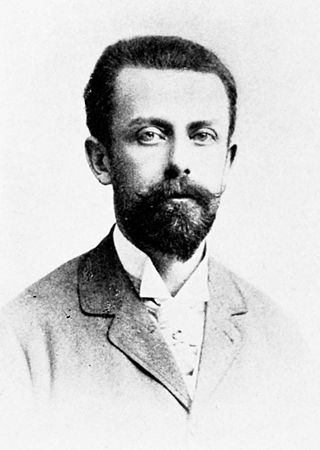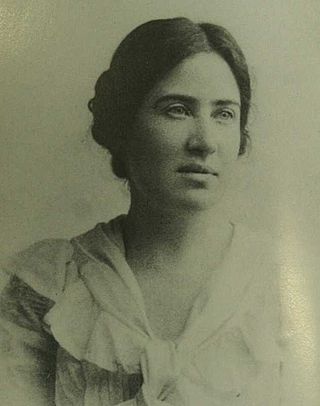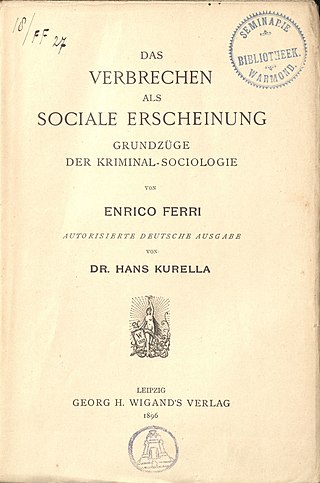Related Research Articles

Cesare Lombroso was an Italian eugenicist, criminologist, phrenologist, physician, and founder of the Italian school of criminology. He is considered the founder of modern criminal anthropology by changing the Western notions of individual responsibility.

Physiognomy or face reading is the practice of assessing a person's character or personality from their outer appearance—especially the face. The term can also refer to the general appearance of a person, object, or terrain without reference to its implied characteristics—as in the physiognomy of an individual plant or of a plant community.

Gabriel Tarde was a French sociologist, criminologist and social psychologist who conceived sociology as based on small psychological interactions among individuals, the fundamental forces being imitation and innovation.
Articles related to criminology and law enforcement.

The Italian school of criminology was founded at the end of the 19th century by Cesare Lombroso (1835–1909) and two of his Italian disciples, Enrico Ferri (1856–1929) and Raffaele Garofalo (1851–1934).

The feminist school of criminology is a school of criminology developed in the late 1960s and into the 1970s as a reaction to the general disregard and discrimination of women in the traditional study of crime. It is the view of the feminist school of criminology that a majority of criminological theories were developed through studies on male subjects and focused on male criminality, and that criminologists often would "add women and stir" rather than develop separate theories on female criminality.

Guglielmo Ferrero was an Italian historian, journalist and novelist, author of the Greatness and Decline of Rome. Ferrero devoted his writings to classical liberalism and he opposed any kind of dictatorship and unlimited government.

Anthropological criminology is a field of offender profiling, based on perceived links between the nature of a crime and the personality or physical appearance of the offender. Although similar to physiognomy and phrenology, the term "criminal anthropology" is generally reserved for the works of the Italian school of criminology of the late 19th century. Lombroso thought that criminals were born with detectable inferior physiological differences. He popularized the notion of "born criminal" and thought that criminality was a case of atavism or hereditary disposition. His central idea was to locate crime completely within the individual and divorce it from surrounding social conditions and structures. A founder of the Positivist school of criminology, Lombroso opposed the social positivism developed by the Chicago school and environmental criminology.

Enrico Ferri was an Italian criminologist, socialist and student of Cesare Lombroso, the founder of the Italian school of criminology. While Lombroso researched the purported physiological factors that motivated criminals, Ferri investigated social and economic aspects. He served as editor of the socialist daily Avanti! and, in 1884, saw his book Criminal Sociology published. Later, his work served as the basis for Argentina’s penal code of 1921. Although at first he rejected the Italian dictator Benito Mussolini, Ferri later became one of Mussolini and his National Fascist Party's main external supporters.

Raffaele Garofalo was an Italian criminologist and jurist.
Nicole Hahn Rafter was a feminist criminology professor at Northeastern University. She received her Bachelor of Arts degree from Swarthmore College in Pennsylvania, achieved her Master of Arts in Teaching from Harvard University, and obtained a Ph.D. in Criminal Justice from State University of New York in Albany. She began her career as a high school and college English professor and switched to criminal justice in her mid-thirties.

Prostitution laws varies widely from country to country, and between jurisdictions within a country. At one extreme, prostitution or sex work is legal in some places and regarded as a profession, while at the other extreme, it is considered a severe crime punishable by death in some other places. A variety of different legal models exist around the world, including total bans, bans that only target the customer, and laws permitting prostitution but prohibiting organized groups, an example being brothels.

Criminology is the interdisciplinary study of crime and deviant behaviour. Criminology is a multidisciplinary field in both the behavioural and social sciences, which draws primarily upon the research of sociologists, political scientists, economists, legal sociologists, psychologists, philosophers, psychiatrists, social workers, biologists, social anthropologists, scholars of law and jurisprudence, as well as the processes that define administration of justice and the criminal justice system.
The feminist pathways perspective is a feminist perspective of criminology which suggests victimization throughout the life course is a key risk factor for women's entry into offending.
Die Psychologie des Verbrechers – Kriminalpsychologie was a book written by Dr. med. Paul Pollitz and published in Leipzig, Germany, in 1916. It is a summary of previous findings on psychological, social and economic characteristics of criminals for a variety of different crime types based on the statistics of the early 20th century. The focus lies on three main causes for committing crimes, which can interact or are presented in solitude. These causes depict crimes as a result of socio-economic circumstances, impaired psyche, and/ or personality of the criminal.

Paul Adolf Näcke was a German psychiatrist and criminologist. Näcke is known for his writings on homosexuality, and coining the term narcissism in 1899 to describe someone who treated his body as a sexual object.

The Criminal is a book by Havelock Ellis published in 1890. A third revised and enlarged edition was subsequently published in 1901. The book is a comprehensive English summary of the main results of criminal anthropology, a field of study which was scarcely known at the time of the publication of the volume. The criminal is the first book published by the author and helped establish his reputation in the scientific world.

Gina Elena Zefora Lombroso was an Italian physician, writer, psychiatrist, and criminologist, best remembered for her uncredited writings on the subjects of criminology and psychiatry co-authored with her father Cesare Lombroso, her individual writings on the female condition and industrialisation. She was the wife of Italian historian and writer Guglielmo Ferrero (1871–1942) and hence adopted the surname Ferrero-Lombroso. Their son Leo Ferrero (1903–1933), a writer and playwright, died in a car accident in Santa Fe (USA). All three are buried at the Cimetière des Rois in Geneva, Switzerland.

Verbrechen und Wahnsinn beim Weibe mit Ausblicken auf die Criminal-Anthropologie überhaupt: klinisch-statistische, anthropologisch-biologische und craniologische Untersuchungen is the first book written by Dr. med Paul Näcke (1851-1913), which was published in 1894. The author aims to fill the gaps present at the time into the research of mentally ill and criminal women based on his own psychiatric observations in the psychiatric institution Hubertusburg, making it unlike literature already available in the era. With his work Näcke goes against the predominant notion of the time that criminals are born, which was based in the positivist school movement at the time and initiated by the "father of criminology": Cesare Lombroso. The main ideas Näcke proposes in his work are that criminals who are insane at time of crime should not be punished as harshly and one should view criminals not solely as objects under the penalty of law but also as subjects who could potentially suffer from mental diseases.

Das Verbrechen als soziale Erscheinung; Grundzüge der Kriminal-Sociologie was written by Enrico Ferri and originally published in 1884, but has undergone several revisions since then. It deals with Ferri's perspective on criminal sociology and problems of penology. The book is known as Ferri's most important work and represents the positive school of criminology.
References
- 1 2 3 4 5 6 7 Bianchi, Augusto Guido; Ferrero, Guglielmo; Sighele, Scipio (1893). Il mondo criminale italiano (in Italian). L.O. Zorini.
- 1 2 3 4 5 6 7 8 Srebnick, Amy Gilman, ed. (2006). Crime and culture: an historical perspective. Advances in criminology (Reprint ed.). Aldershot: Ashgate. ISBN 978-0-7546-2383-0.
- ↑ Gibson, Mary (2000). Prostitution and the State in Italy, 1860-1915. Ohio State University Press. ISBN 978-0-8142-5048-8.
- ↑ Lombroso, Cesare; Ferrero, Guglielmo; Rafter, Nicole Hahn; Gibson, Mary; Lombroso, Cesare (2004). Criminal woman, the prostitute, and the normal woman. Durham, NC: Duke University Press. ISBN 978-0-8223-3246-6.